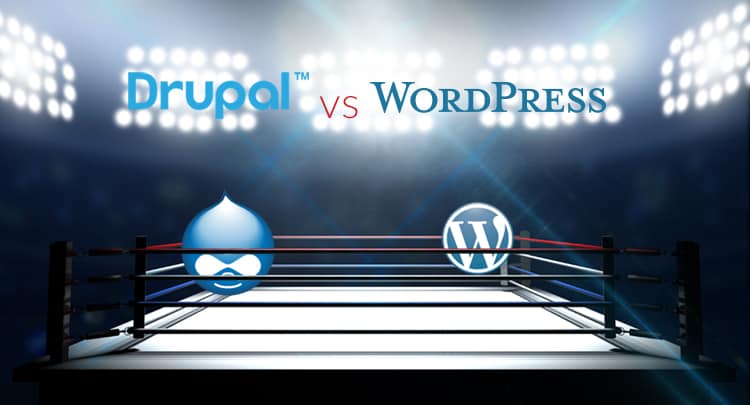As a website design and development agency that regularly uses two of the most prominent, open-source Content Management Systems (CMS)—WordPress and Drupal—we too have internal battles about which jobs we’ll use each of these excellent tools.

To provide some clarity about the powerful platforms WordPress and Drupal, we thought it best to put our two lead developers to the task of sharing the strengths and weaknesses of each system.
In the WordPress Corner: Nathan Smith, Lead WordPress Developer
In the Drupal Corner: Brandon Williams, Senior Back-end Developer
Strengths of WordPress:
- It has a user-friendly administrative dashboard.
- It has a less drastic learning curve.
- WordPress provides 80 percent of what most websites need; the remaining 20 percent are added with plugins or custom development.
- It supports a vast plugin ecosystem (currently at 43,415 free plugins).
- Plugins are extensions to the core WordPress platform that provide additional functionality.
- It has a vast theme ecosystem.
- WordPress themes are pre-designed; they provide additional functionality and reduce design costs.
- WordPress currently powers roughly 40 percent of all CMS-based websites.
- This provides a larger pool of resources and talent from which to pull.
- BuddyPress is an extension of WordPress that can turn a site into a social-networking platform.
Strengths of Drupal:
- It’s more powerful and can more easily accomplish complex functionality.
- The organizational structure of the database uses a more standard approach. It’s easier to query specific fields—and complex data—within the database.
- Custom content queries and displays may be created by non-programmers using the Views module with a GUI to create filters and display them.
- GUI = Graphical User Interface
- Drupal has a large number of modules that extend its functionality; they’re reviewed to maintain security.
- Data manipulation is easier.
- Drupal provides detailed security reports and boasts enterprise-level security.
Negatives of WordPress:
- It doesn’t easily handle complex data queries.
- This means you’ll need to enable other tools, like page caching.
- The meta storage is not as well organized (structured).
- The meta query is very inefficient to query against to get subsets of data.
- It requires a developer or plugin to create a custom Loop, with PHP code (what Drupal does with Views).
- PHP programming typically is required to display custom content on the site.
Negatives of Drupal:
- The administration of a Drupal site is more advanced and has a much steeper learning curve: It requires more time to learn and use the administration features and update the website.
- It takes more time to create and manage because of the complexity, which ultimately costs more.
Trade-offs:
- It’s easier to store data with WordPress, but it’s less efficient to query that data back out.
- WordPress is one of the most widely used website CMSs, which makes it the most likely to be attacked by hackers, but it also has the most developers providing defense.
- In Drupal it’s more complicated to set up new fields for data storage, but it’s easier to query that data back out.
- Drupal can handle more complicated data structures, but it requires more time to set up.
In Summary:
The right CMS for the job is based largely on the specific project requirements and business needs. WordPress is best for more basic, marketing-based websites and blogs, but it can use plugins to extend its functionality for reduced costs. Drupal is best used for more complex websites and web applications with complicated databases, complex database queries and functionality.